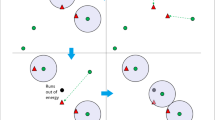Abstract
The network lifetime and application requirement are two fundamental, yet conflicting, design objectives in wireless sensor networks for tracking mobile objects. The application requirement is often correlated to the delay time within which the application can send its sensing data back to the users in tracking networks. In this paper we study the network lifetime maximization problem and the delay time minimization problem together. To make both problems tractable, we have the assumption that each sensor node keeps working since it turns on. And we formulate the network lifetime maximization problem as maximizing the number of sensor nodes who don’t turn on, and the delay time minimization problem as minimizing the routing path length, after achieving the required tracking tasks. Since we prove the problems are NP-complete and APX-complete, we propose three heuristic algorithms to solve them. And we present several experiments to show the advantages and disadvantages referring to the network lifetime and the delay time among these three algorithms on three models, random graphs, grids and hypercubes.
Preview
Unable to display preview. Download preview PDF.
Similar content being viewed by others
References
Bern, M., Plassmann, P.: The steiner problem with edge lengths 1 and 2. Information Processing Letters 32, 171–176 (1989)
Chen, Y., Fleury, E.: A Distributed Policy Scheduling for Wireless Sensor Networks. In: INFOCOM 2007. IEEE, Anchorage (2007)
Floreen, P., Kaski, P., Suomela, J.: A distributed approximation scheme for sleep sceduling in sensor networks. In: SECON 2007, San Diego, CA (2007)
He, T., Krishnamurthy, S., Stankovic, J.A., Abdelzaher, T., Luo, L., Stoleru, R., Yan, T., Gu, L., Hui, J., Krogh, B.: Energy-efficient surveillance system using wireless sensor networks. In: International Conference On Mobile Systems, Applications And Services, Boston, MA, USA, pp. 270–283 (2004)
He, T., Vicaire, P., Yan, T., Luo, L., Gu, L., Zhou, G., Stoleru, R., Qing, C., Stankovic, J.A., Abdelzaher, T.: Achieving Real-Time Target Tracking UsingWireless Sensor Networks. In: Proceedings of the 12th IEEE on Real-Time and Embedded Technology and Applications Symposium, April 2006, pp. 37–48 (2006)
Keshavarzian, A., Lee, H., Venkatraman, L.: Wakeup Scheduling in Wireless Sensor Networks. In: MobiHoc 2006, Florence, Italy, May 22-25 (2006)
Sinha, A., Chandrakasan, A.: Dynamic Power Management in Sensor Networks. IEEE Design & Test of Computers 18(2), 62–74 (2001)
Subramanian, L., Katz, R.H.: An architecture for building self-configurable systems. In: MOBIHOC 2000, Boston, USA, pp. 63–73 (2000)
Tran, S., Yang, T.: Evaluations of target tracking in wireless sensor networks. In: Proceedings of the 37th SIGCSE technical symposium on Computer science education, Houston, Texas, USA, pp. 97–101 (2006)
Author information
Authors and Affiliations
Editor information
Editors and Affiliations
Rights and permissions
Copyright information
© 2009 Springer-Verlag Berlin Heidelberg
About this paper
Cite this paper
Liu, L., Li, H., Wang, J., Li, L., Li, C. (2009). Heuristics for Mobile Object Tracking Problem in Wireless Sensor Networks. In: Deng, X., Hopcroft, J.E., Xue, J. (eds) Frontiers in Algorithmics. FAW 2009. Lecture Notes in Computer Science, vol 5598. Springer, Berlin, Heidelberg. https://doi.org/10.1007/978-3-642-02270-8_26
Download citation
DOI: https://doi.org/10.1007/978-3-642-02270-8_26
Publisher Name: Springer, Berlin, Heidelberg
Print ISBN: 978-3-642-02269-2
Online ISBN: 978-3-642-02270-8
eBook Packages: Computer ScienceComputer Science (R0)




